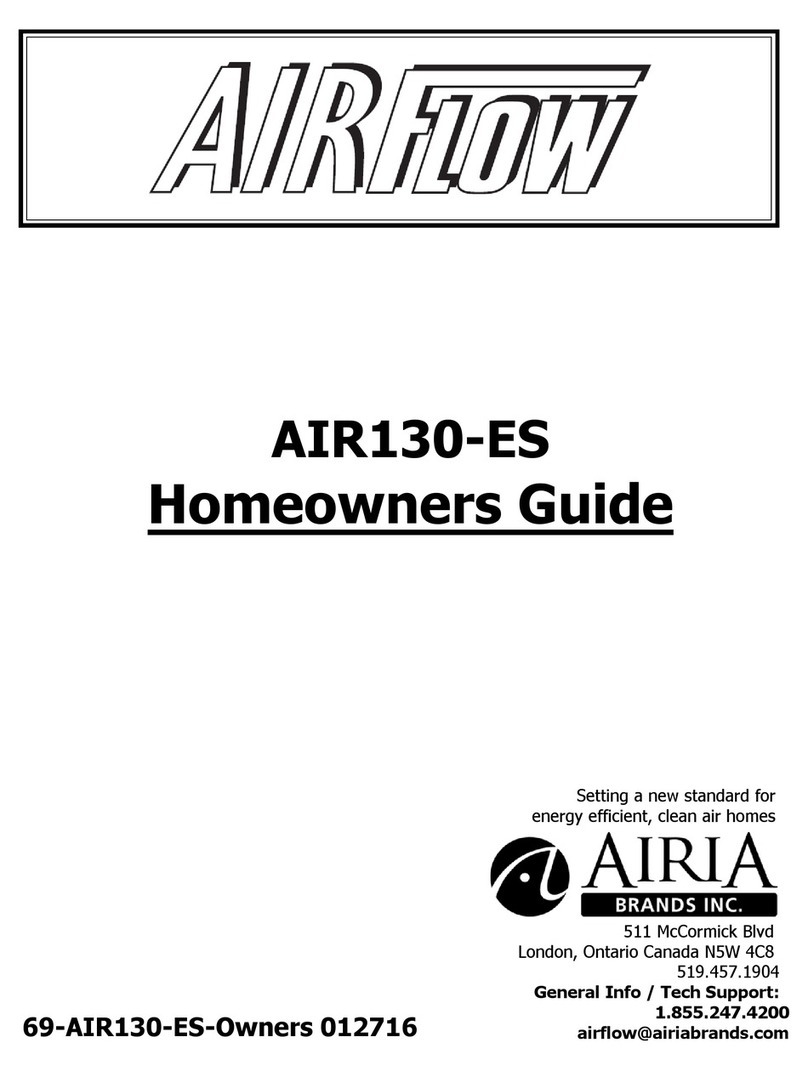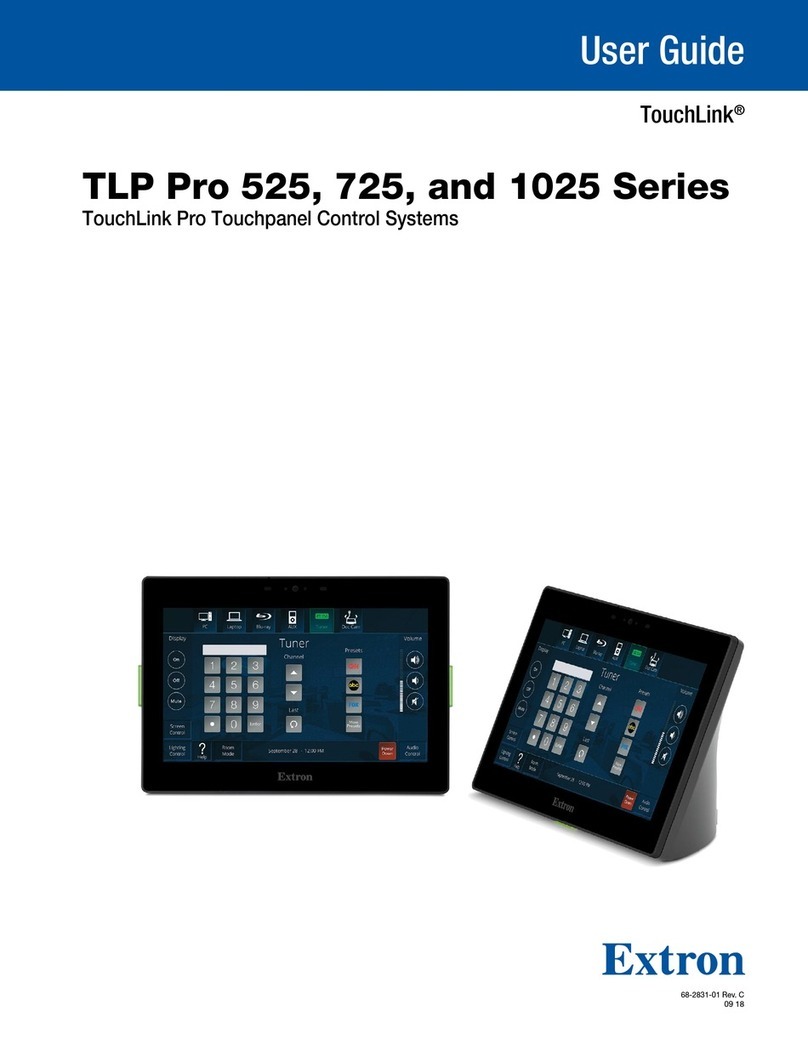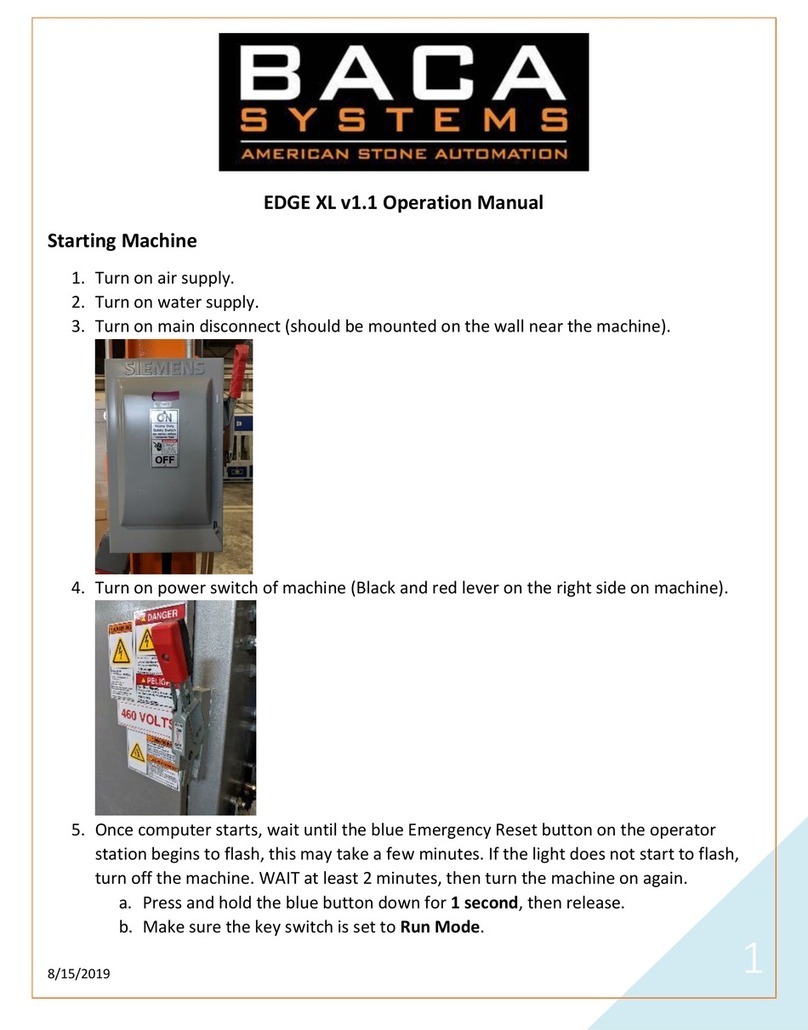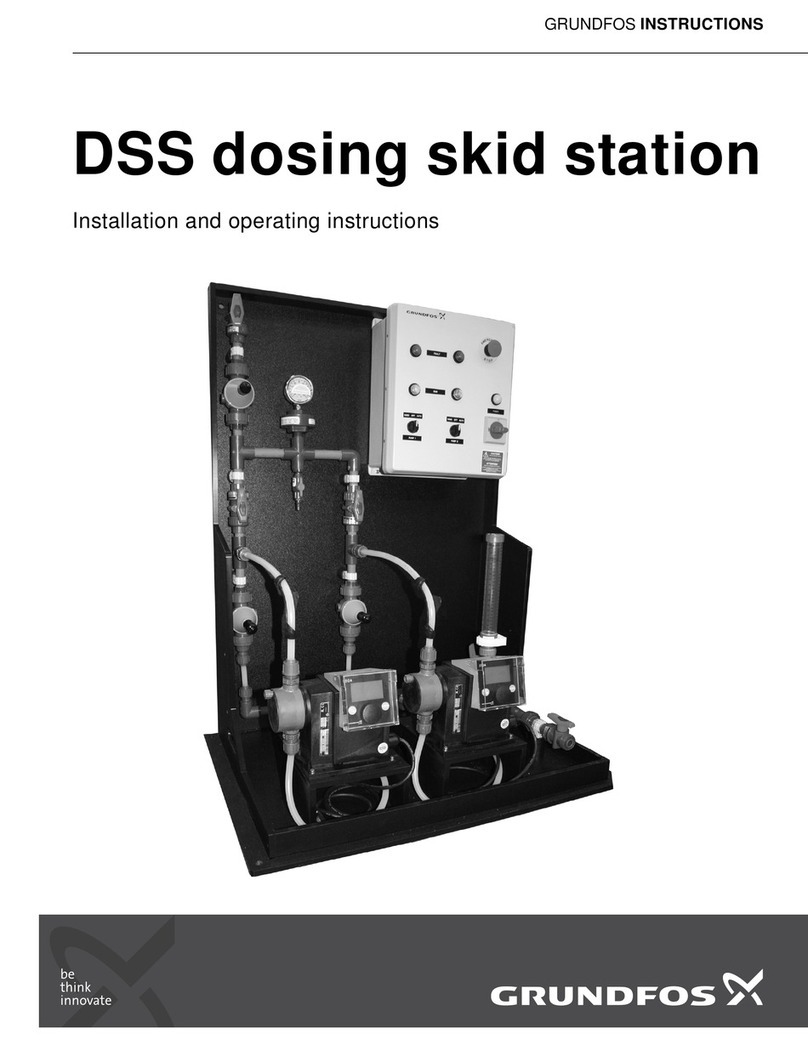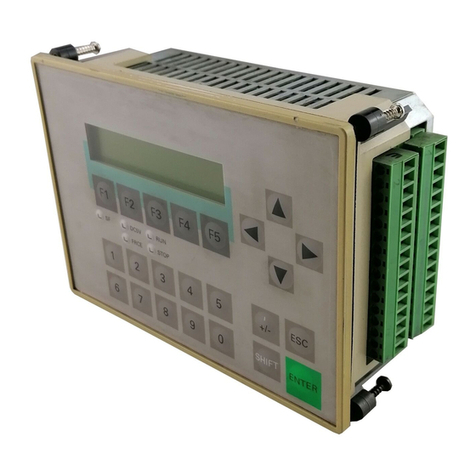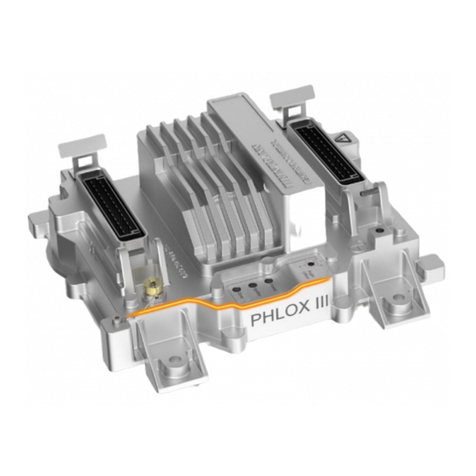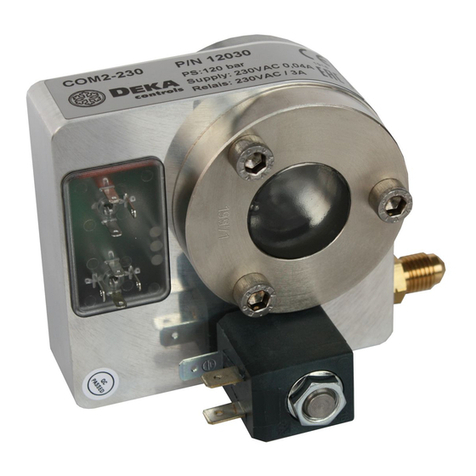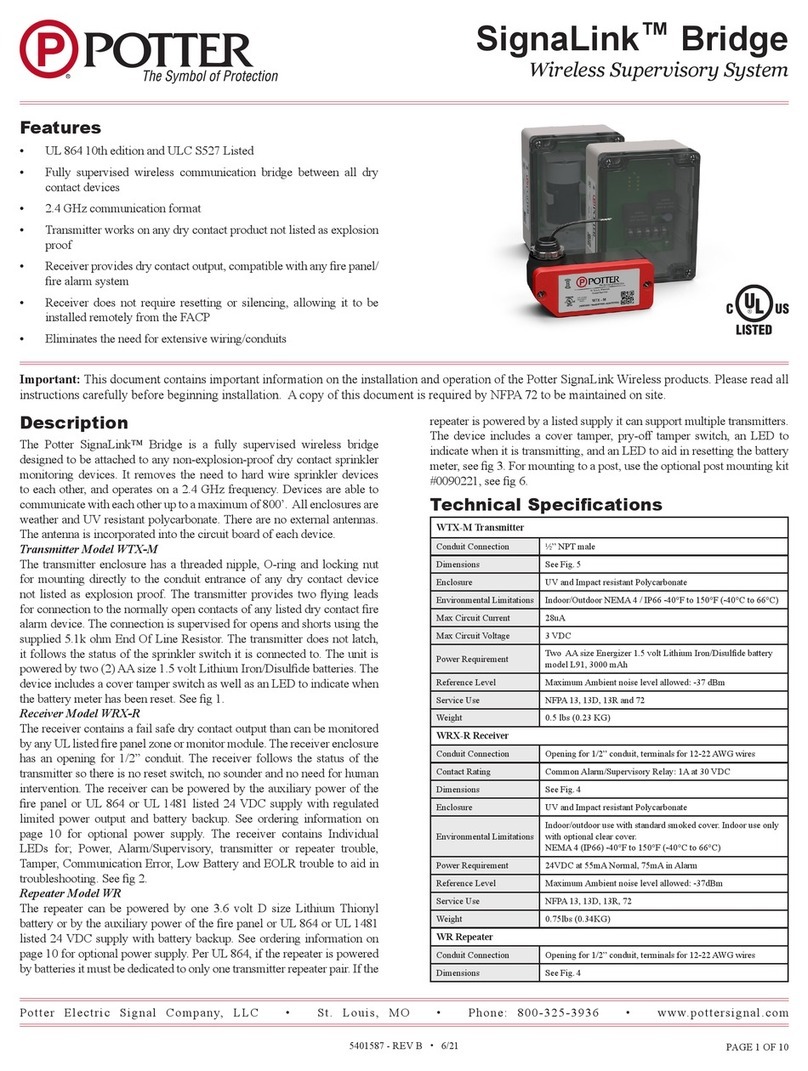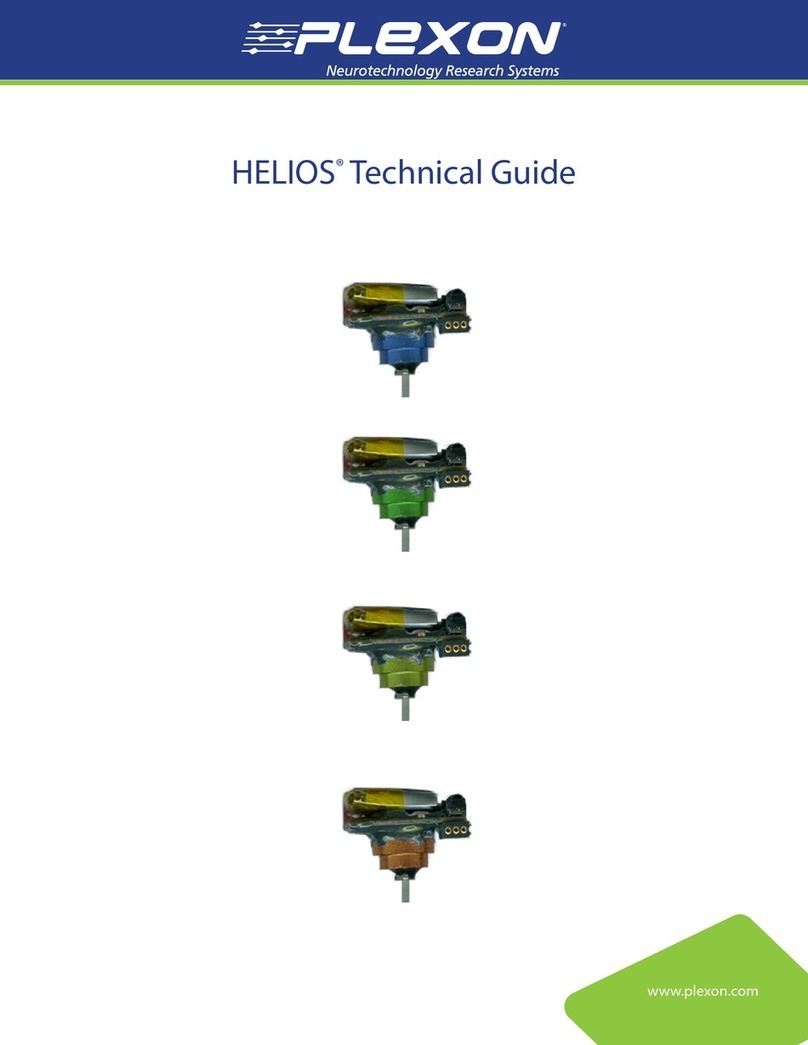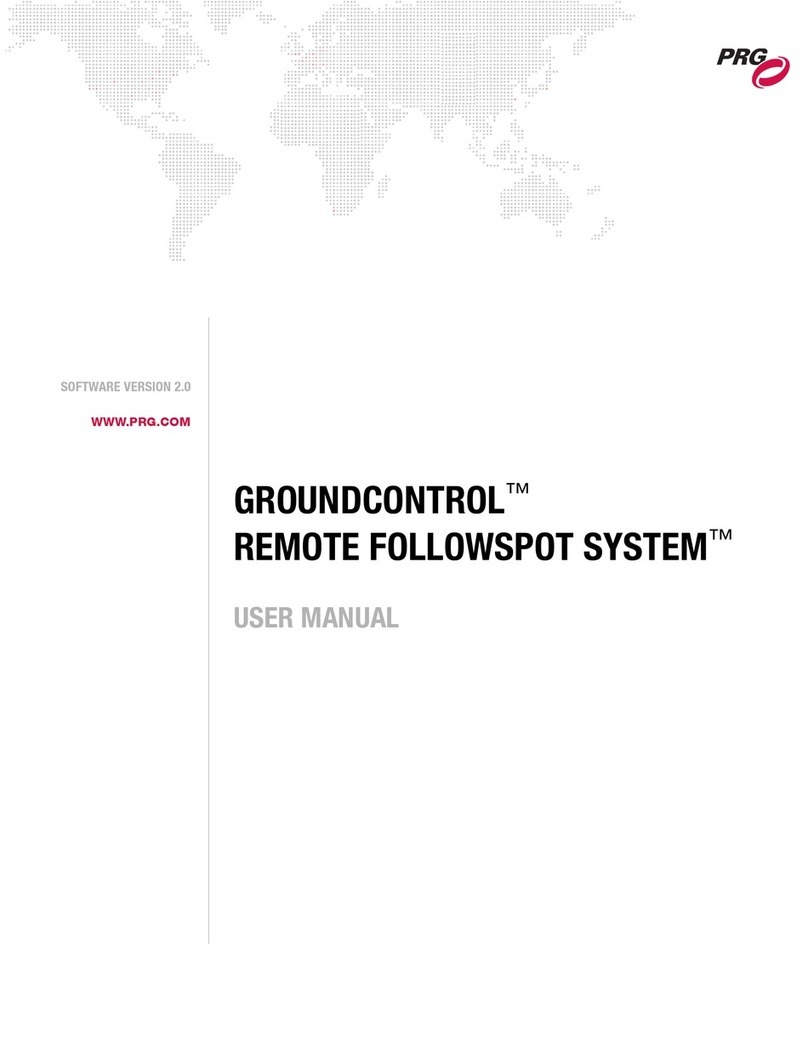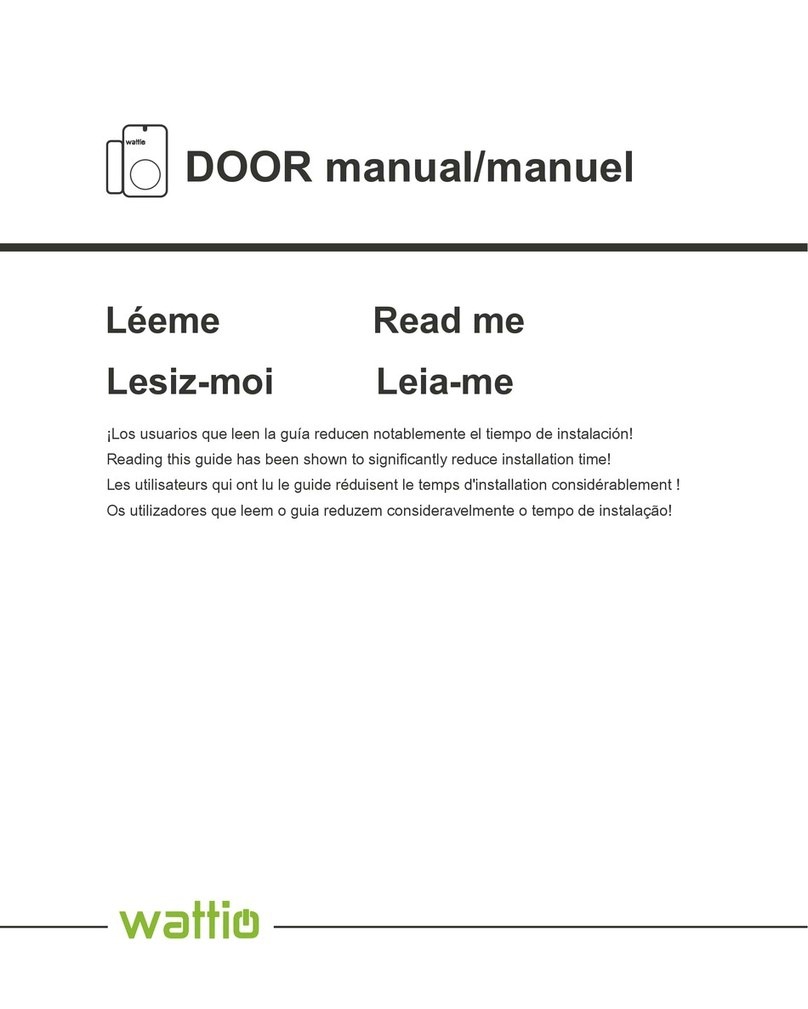Fike Epaco User manual

User’s Manual
P/N E06-091, Rev. 0
January 2010
EXPLOSION PROTECTION (ACTIVE) CONTROL SYSTEM

DEVELOPED BY Fike
704 SW 10th Street
P.O. Box 610
Blue Springs, Missouri 64013 U.S.A.
Phone: (888) 628-FIKE (3453)
(816) 229-3405
Fax: (866) 211-9239
COPYRIGHT NOTICE Copyright 2010, All rights reserved.
Fike copyrights this manual and products it describes. You may not reproduce,
transmit, transcribe, or any part of this manual without express, written
permission from Fike.
This manual contains proprietary information intended for distribution to
authorized persons or companies for the sole purpose of conducting business
with Fike. If you distribute any information contained in this manual to
unauthorized persons, you have violated all distributor agreements and we may
take legal action.
TRADEMARKS Fikeis a registered trademark of Fike.
QUALITY Fike has maintained ISO 9001 certification since 1996. Prior to shipment, we
thoroughly test our products and review our documentation to assure the highest
quality in all respects.
WARRANTY Fike provides a one-year limited manufacturer’s warranty on this product. All
warranty returns must be returned from an authorized Fike Distributor. Contact
Fike’s Marketing department for further warranty information.
Fike maintains a repair department that is available to repair and return existing
electronic components or exchange/purchase previously repaired inventory
component (advance replacement). All returns must be approved prior to return.
A Material Return Authorization (MRA) number must be indicated on the box of
the item being returned. Contact the appropriate Regional Sales Manager for
further information regarding product return procedures.
LIMITATIONS OF LIABILITY Installation in accordance with this manual, applicable codes, and the
instructions of the Authority Having Jurisdiction is mandatory. Fike can not be
held liable for any incidental or consequential damages arising from the loss of
property or other damages or losses resulting from the use or misuse of Fike
products beyond the cost of repair or replacement of any defective components.
Fike reserves the right to make product improvements and change product
specifications at any time.
While every precaution has been taken during the preparation of this manual to
ensure the accuracy of its content, Fike assumes no responsibility for errors or
omissions.

EPACO USER’S MANUAL
Revision Date: January, 2010 P/N E06-091 (Rev 0)
REVISION HISTORY
Document Name: EPACO USER’S MANUAL
Original Release Date:..................................................................................................................January, 2010
Revision / Description of Change Revision Date

EPACO USER’S MANUAL
P/N E06-091 (Rev 0) Revision Date: January, 2010
TABLE OF CONTENTS
SECTION PAGE NO.
1.0 INTRODUCTION.......................................................................................................................................... 1
1.1 PRODUCT SUPPORT ................................................................................................................................. 1
1.2 SAFETY INFORMATION ............................................................................................................................. 1
1.3 RELATED DOCUMENTATION .................................................................................................................... 2
2.0 EPACO™ SYSTEM OVERVIEW................................................................................................................. 3
2.1 EXPLOSION PROTECTION CONTROLLER.............................................................................................. 4
2.1.1 OPERATION.............................................................................................................................................. 5
2.1.2 EPC DIAGNOSTICS ................................................................................................................................. 6
2.1.3 EPC SPECIFICATIONS ............................................................................................................................ 7
2.2 POWER SUPPLY UNIT ............................................................................................................................... 8
2.2.1 OPERATION.............................................................................................................................................. 8
2.2.2 PSU DIAGNOSTICS ................................................................................................................................. 9
2.2.3 PSU SPECIFICATIONS .......................................................................................................................... 10
2.2.4 PSU VOLTAGE CHART.......................................................................................................................... 11
2.3 ANNUNCIATOR MODULE........................................................................................................................ 12
2.3.1 OPERATION............................................................................................................................................ 12
2.3.2 AM SPECIFICATIONS ............................................................................................................................ 14
2.4 RELAY CARD MODULE ........................................................................................................................... 15
2.4.1 OPERATION............................................................................................................................................ 15
2.4.2 RC8 LED DIAGNOSTICS........................................................................................................................ 15
2.4.4 RC8 SPECIFICATIONS .......................................................................................................................... 16
3.0 MAINTENANCE......................................................................................................................................... 17
3.1 ROUTINE INSPECTION ............................................................................................................................ 17
4.0 DECOMMISSIONING PROCEDURE....................................................................................................... 18
APPENDIX A-RC8 MODULE STATUS CODES.............................................................................................. 19
APPENDIX B–ANNUNCIATOR MODULE DISPLAY HISTORY CODES........................................................ 24
APPENDIX C-PRESSURE CORRELATION CHART ...................................................................................... 25

EPACO USER’S MANUAL
Revision Date: January, 2010 P/N E06-091 (Rev 0) Page: 1
1.0 INTRODUCTION
This manual is intended for those individuals who are responsible for the interfacing with Fike’s EPACO
explosion protection system. The first-time operator should thoroughly read and understand the instructions
contained within this manual before interfacing with the EPACO system components.
1.1 PRODUCT SUPPORT
If you have any questions or encounter a problem not covered in this manual, you should first try to contact
the Fike Explosion Protection distributor that installed the system as noted below.
For technical support, please contact:
Company Name: _________________________________________
Phone Number: _________________________________________
Fax Number: _________________________________________
E-Mail Address: _________________________________________
If you can not locate the distributor, please call Fike Customer Service using the numbers indicated bellow for
assistance in locating your nearest distributor, or go to our web-site at www.fike.com.
Fike Blue Springs, USA
Phone: +1-816-229-3405
+1-800-979-FIKE (3453)
Option 23 Explosion Protection Support
Fax: +1-816-229-0314
Or
Fike Europe
Phone: +32-14-21-00-31
Fax: +32-14-21-07-43
1.2 SAFETY INFORMATION
Important safety admonishments are used throughout this manual to warn of possible hazards to persons or
equipment.
aWARNING
Warnings are used to indicate the presence of a hazard
which will or may cause personal injury or death, or loss of
service if safety instructions are not followed or if the hazard
is not avoided.
ICaution
Cautions are used to indicate the presence of a hazard
which will or may case damage to the equipment if safety
instructions are not followed or if the hazard is not avoided.
LNotes: Notes indicate the message is important, but is not
of a Warning or Caution category. These notes can be of
great benefit to the user and should be read.

EPACO USER’S MANUAL
Page: 2 P/N E06-091 (Rev 0) Revision Date: January, 2010
1.3 RELATED DOCUMENTATION
Document Title Part Number
EPACO System, Explosion Protection Controller (EPC) Installation and Operation Manual E06-051
EPACO System, Explosion Protection Controller (EPC) Solenoid Installation and Operation
Manual E06-090
EPACO System, Power Supply Unit (PSU) Installation and Operation Manual E06-052
EPACO System, Annunciator Module (AM) Installation and Operation Manual E06-053
EPACO System, Relay Card (RC8) Installation and Operation Manual E06-054

EPACO USER’S MANUAL
Revision Date: January, 2010 P/N E06-091 (Rev 0) Page: 3
2.0 EPACO™ SYSTEM OVERVIEW
The EPACOexplosion detection and control system is comprised of explosion detectors, control unit (EPC),
power supply unit (PSU), optional annunciator module (AM) and relay cards (RC8). EPACOcombines the
latest in addressable technology with simplicity of installation and maintenance. All system modules are DIN
rail mounted to allow for a variety of installation options. Three (3) bus type communication circuits tie the
various system modules into one easy to operate protection system. A non-volatile history buffer allows for
enhanced diagnostic ability to troubleshoot process situations. The optional Annunciator Module (AM), the
customer has the ability to step through a menu format to retrieve process history without having to wait for a
service agency to arrive on site.
EPACOis designed to detect and control any of Fike’s Active explosion suppression and isolation systems;
which range from chemical suppression, mechanical isolation (gate and pinch valve), chemical isolation or
any combination thereof. Detection is achieved by either pressure and/or flame radiation detectors designed
to sense the incipient explosion and trigger the explosion suppression and/or isolation systems.
EPACO System Block Diagram
2A2A2A2A2A2A
RC8 AMEPC-3 EPC-4EPC-1 EPC-2
24VDC
VOLTAGE
25VAC
OUTPUT
DB9
24VDC
DB9
ADD
2A
2
4
1
3
24VDC
6
DB9
5
ADD MODE
78
2A
1
2
34
- 2A -
DB9
ADD MODE
24VDC
2A
R
EIGHT (8) PROGRAMMABLE RELAYS
NEMA ENCLOSURE
ALARM RELAY
TROUBLE/SUPERVISORY RELAY
SERIES FIRING CIRCUIT UP
TO (6) RELEASING DEVICES
CHEMICAL
ISOLATION MECHANICAL
ISOLATION
SUPPRESSION
CONTAINER
GATE VALVE
DETECTION
CIRCUIT #2
DETECTION
CIRCUIT #1
SYSTEM DISABLE INPUT
SUPERVISORY INPUT
CONTACT CLOSURE INPUT
OR DETECTION CIRCUIT #3
XFMR
BATTERY BATTERY
NOTES:
1. MAXIMUM OF FOUR (4) EPC'S PER EPACO
SYSTEM. EACH CAPABLE OF SUPPORTING TWO
4-20 mA DETECTORS.
2. CAPABLE OF SUPPLYING POWER TO FOUR (4)
RELAY CARDS, FOUR (4) EPC CONTROLLERS AND
ONE (1) ANNUNCIATOR MODULE.
3. CAPABLE OF SUPPORTING FOUR (4) RELAY
CARDS, FOUR (4) EPC CONTROLLERS AND ONE
(1) POWER SUPPLY UNIT.
4. MAXIMUM OF FOUR (4) RELAY CARDS PER
ANNUNCIATOR MODULE.

EPACO USER’S MANUAL
Page: 4 P/N E06-091 (Rev 0) Release Date: January, 2010
2.1 EXPLOSION PROTECTION CONTROLLER
The Explosion Protection Controller (EPC) is the cornerstone of
the EPACOsystem. The EPC is an addressable panel that has
the ability to retain an event history for enhanced system
diagnostics. The EPC is DIN rail mounted which allows mounting
of the controller in close proximity to the protected environment,
thereby minimizing field wiring. Shorter wire runs greatly reduce
the interference from electrical and radio frequency sources,
allowing for a much more reliable protection system.
The EPC’s detection inputs can be programmed for pressure
warning, threshold detection, and rate of rise detection. It also
has a contact closure detection circuit to support thermal, infrared,
or other switch-closure type detection devices. A supervisory
input circuit is provided to monitor suppression container pressure
or other similar system status safeguards. The EPC has a remote
disable input contact to allow for disabling the EPC from a
customer PLC or other remote device during product loading,
cleaning, or maintenance. An RS232 connection is available at
each module for connection to a PC. Using the EP WorksTM
software, an authorized user can access system diagnostics and
perform complex programming by PC.
The following tasks are accomplished by the EPC:
Monitors all supervised circuits for wiring faults (Open, Short, or Activation)
Two detection circuits are monitored on a 250 micro second (0.25 msec) rate and examined for rate
of rise and threshold levels
When activation requirements are met by the detection circuit, it activates the series firing output
within 2 milli-seconds
Communicates system status to other EPC’s connected locally so that they can respond within 4 milli-
seconds
Communicates system status to Annunciators and Relay Control Modules for user interface

EPACO USER’S MANUAL
Release Date: January, 2010 P/N: E06-091 (Rev 0) Page: 5
2.1.1 OPERATION
The EPC is equipped with three (3) colored LEDs that provide instant visual indication of system status. EPC
operation can be classified into three main states: Normal, Trouble and Alarm. A general description of each
state is described below.
EPC Normal State
When power is applied to the EPC, it performs a 4 second initialization. At the
end of the initialization, the trouble LED blinks slow and the local piezo beeps in
long recurring sound. It can then enter the “NORMAL” state if the power is of an
appropriate voltage and there are no troubles or alarms. In the Normal State the
green Power LED is ‘ON’, the local piezo is ‘OFF’, the trouble and alarm relays
are energized. All other LED’s are ‘OFF’.
EPC Trouble State
A trouble occurs on the EPC if any one of the supervised circuits experiences a
wiring fault open or short condition, if the EPC configuration is invalid, if the
system is disabled, if a process pressure warning level is exceeded, or if the input
voltage drops below 18VDC. In the Trouble State the yellow Trouble LED is ‘ON’,
the local piezo is ‘ON’, and the P6 trouble relay is de-energized. Depending on
the cause of the trouble, the system may or may NOT be completely functional.
Each trouble should be investigated to determine the cause and promptly fixed.
Each trouble, except for remote disable, will latch at the EPC. If the trouble is
resolved, the EPC trouble can be cleared by disabling and re-enabling via the
remote disable input, by cycling of the power input to the EPC, or by disabling
and re-enabling the EPC via the Annunciator Module. If the remote disable is
active, the EPC will enter the trouble state. When the remote disable is returned
to normal, the EPC will automatically clear to the normal state, if no other troubles
are present, without cycling the power.
EPC Alarm State
When the detection circuits have exceeded the alarm conditions required by the
configuration, the EPC enters the Alarm State. In the Alarm State the red Alarm
LED is ‘ON’, the local piezo ‘ON’, the Alarm relay is de-energized, and the series
firing output is activated. The alarm state is latching. If the alarm is cleared, the
EPC requires cycling of the power input to clear the alarm.
Red
24VDC
Green
Yellow

EPACO USER’S MANUAL
Page: 6 P/N E06-091 (Rev 0) Release Date: January, 2010
2.1.2 EPC DIAGNOSTICS
In addition to the EPC’s three system status LEDs, an integral buzzer is provided to assist in diagnosing
problems with the system. The following table identifies how the LEDs and buzzer will operate in response to
expected system events.
Power
LED
on
on
on
on
on
on
on
on
on
on
on
on
on
Piezo
off
long-short
pulse
short-short
pulse
long
pulse
off
on not
latched
off
on
off
on
off
on not
latched
off
Trouble
LED
on
on
on
blink slow
off
on latched
on
on (1)
on
on
off
on latched
no change
Trouble
Relay
De-energized
De-energized
De-energized
De-energized
Energized
De-energized
latched
De-energized
De-energized
(1)
De-energized
De-energized
Energized
De-energized
latched
no change
Alarm Relay
De-energized
De-energized
De-energized
Energized
Energized
Energized
Energized
De-energized
Energized
Energized
Energized
Energized
no change
Alarm LED
off
slow blink
off
off
off
off
off
on
on
on
fast blink
off
off
Condition
Initial power up [first 4 seconds]
Power up in an alarm state
Invalid configuration or
Prevent restart after activation
Initializing [follows initial power up]
Normal State
Trouble State
Disabled State
Alarm State
Disabled State & alarm
Return to Armed from previous state
1st alarm in AND configuration
[cross zoned]
Warning pressure level
PC mode
(1) Trouble relay and LED following trouble condition on series firing output due to release action.

EPACO USER’S MANUAL
Release Date: January, 2010 P/N: E06-091 (Rev 0) Page: 7
2.1.3 EPC SPECIFICATIONS
Part Number: E10-0066
Input Power: 18 to 30 VDC; 300mA
Max. Noise Ripple: 500mV peak at 24 VDC
Fuse: 2A Mini Automotive Type
Lower Limit for Input Power
Shut-down: 16 VDC
Power Consumption: 275mA in Normal State
300mA in Trouble State
200mA in Alarm State
Terminal Block Capacity: 1.5 to 0.14 mm2(16 to 28 AWG)
Input Circuits:
4-20mA: Two detection circuits with maximum resistance of 30 Ω. Minimum 2x 0.5mm2(20 AWG)
twisted shielded pair cable with drain wire.
If the 4-20mA pressure detectors are placed in a hazardous atmosphere a Fike approved
transmitter power supply shall be used on each detection circuit.
Switch Closure: One detection circuit, 24 VDC at 0.10A with a maximum resistance of 30 Ω. Minimum 2 x
0.5 mm2(20 AWG) twisted shielded pair cable with drain wire, class A or class B wiring.
Supervisory Input: One switch closure 24 VDC at 0.10A with a maximum resistance of 30 Ω. Minimum 2 x 0.5
mm2(20 AWG) twisted shielded pair cable with drain wire, class B wiring.
Disable Input: One switch closure 24 VDC at 0.10A with a maximum resistance of 30 Ω. Minimum 2 x 0.5
mm2(20 AWG) twisted shielded pair cable with drain wire, class B wiring.
Series Firing Output Circuit: Voltage and current rating 50 VDC, 3.5A. Maximum loop resistance including actuator(s) is
10 Ω. Each actuator is typically 0.7 Ω. Minimum wire size 2 x 0.75 mm2(18 AWG).
Maximum number of actuators: Six (6).
iCAUTION
Do not measure the resistance of the actuator(s) with a meter. The
meter may provide a current that will activate the actuator.
Relay Output: One SPDT Form C for Trouble; One SPDT Form C for Alarm.
Both rated DC operation: 2 amps @ 30VDC (pf=0.35)
AC operation: 0.5 amps @ 250VAC (pf=0.35)
Fire Bus: Wire specification Alpha wire or RE-Y2Y or Belden 9841, maximum resistance of 50 Ω,
inductance L=100uH, capacitance C=0.02uF, maximum length 1,000 ft (300 m) total.
Status Bus: Wire specification Alpha wire or RE-Y2Y or Belden 9841, maximum resistance of 50 Ω,
inductance L=100uH, capacitance C=0.02uF, maximum length 1,000 ft (300 m) total.
Temperature Rating: -18°C to 60°C (0°F to 140°F). If EPC is located inside auxiliary housing, maximum
temperature is 43.3°C (110°F).
Humidity: 80% relative, maximum (non-condensing).
Size: 200 m L x 130 mm H x 60 mm D (7.7” L x 5.2” H x 2.3” D).
Weight: 0.68 kg (1.5 lbs.).
System Pressure Tolerance: 0.9% of transducer span, 600 mbar (8.7 psi), using the Ceramic pressure transducer, P/N
29945022-S, and EPC, P/N E10-0066, i.e. 5 mbar (0.08 psi).
Hazardous Area: The EPC is not rated for hazardous atmospheres. The EPC must be located in an auxiliary
housing that is rated for the hazardous atmosphere in which it is located.
For FM installations the EPC must be located in a non-hazardous atmosphere.
To maintain the systems ATEX Approval the housing shall be an ATEX approved housing
supplied by Fike.
Current Firmware Version: Can be verified using EPWorksSoftware.

EPACO USER’S MANUAL
Page: 8 P/N E06-091 (Rev 0) Release Date: January, 2010
2.2 POWER SUPPLY UNIT
The Power Supply Unit (PSU) is the primary power source for
the EPACOsystem. The PSU can operate with AC power
using selected transformers with 100V, 120V, or 240V 50/60Hz
input (ordered separately).
The PSU has six (6) separate fused 24 VDC, 1 amp power
output circuits capable of powering up to four EPCs in addition to
an Annunciator Module (AM) and four (4) Relay Card Modules
(RC8). Each output is protected with a 2 Amp fuse and
supervised for high and low voltage. Power to the Annunciator
Module can not be shut off; all other power circuits can be shut
off for service on the various system components.
The PSU has the flexibility of containing its own battery backup
supply or the customer has the option of supplying a backup
power source. The PSU has an imbedded power shutdown
procedure in the event of AC power failure, which prevents the
backup batteries from being completely depleted. The PSU may
be eliminated if battery backed, uninterrupted 24VDC, 2 amps
power can be provided by others.
The PSU is equipped with an internal cooling fan that is supervised for normal operation.
2.2.1 OPERATION
Startup
Upon startup, the AC power is measured for a normal level. If the AC power is too high or too low, the PSU is
held until a normal level is reached. The AC LED is updated accordingly. Once normal AC power is verified,
the output voltage is measured. Output voltage must be within normal boundaries to enable the PSU to
continue.
The PSU then detects if batteries are connected with an appropriate voltage level for battery backup
operation. When the battery level is found normal or low, the battery charging circuit is enabled. In cases
where the back-up battery voltage exceeds 29.5 VDC, the charging circuit is switched off and the battery will
not be switched in line with the output power.
The five switch-able output circuits are measured (while in the OFF state) through a supervision circuit to
determine the load connected to the lines. In case the load is too high, the corresponding output is left
disabled. If the load is found to be appropriate, the output circuit is switched ON to power up the connected
devices. The output lines are routinely measured for high loads or excessive voltages. The normal output
voltage must be between 18VDC and 30VDC.
The complete startup sequence typically is completed within 10 seconds; otherwise a problem has occurred
and should be resolved prior restarting the PSU
Normal Operation
After the startup sequence, normal operation is entered. During this operation, the AC and DC power LED’s
are both Green; the output voltage and trouble LED’s are OFF. This operation can only be stopped in case of
total shutdown of the PSU or when a PC is connected and PC mode becomes active. In this mode of
operation, AC power, output voltage, charge power, output lines and battery are continuously measured.
Upon meeting these systems’ parameters, the LED’s are updated and history is created. When the
parameters are not met, the trouble relay de-energizes and the trouble LED is lit.

EPACO USER’S MANUAL
Release Date: January, 2010 P/N: E06-091 (Rev 0) Page: 9
2.2.2 PSU DIAGNOSTICS
The PSU is equipped with four (4) diagnostic LEDs. The following table identifies how the LEDs will operate
in response to expected system events.
Status 25VAC Output Voltage 24VDC Battery Trouble
Normal Status GREEN GREEN GREEN OFF
Normal AC Power GREEN n/a n/a n/a
No AC Power OFF n/a n/a ON
Low AC Power RED n/a n/a ON
High AC Power RED BLINK n/a n/a ON
Normal Battery Power n/a n/a GREEN n/a
No Battery n/a n/a OFF ON
Battery off n/a n/a RED ON
Battery Shutdown n/a n/a RED ON
Battery Low n/a n/a GREEN BLINK ON
Battery High n/a n/a RED BLINK ON
Normal Charge Power n/a n/a n/a n/a
Charger Power Fail n/a n/a RED ON
Normal Output Power n/a GREEN n/a n/a
Low Output Power n/a GREEN BLINK n/a ON
High Output Power n/a RED n/a ON
Fan Trouble n/a n/a n/a BLINK
Ground Fault n/a n/a n/a ON
LNote: Trouble Relay is energized when Trouble LED is OFF, except when Trouble LED is blinking.
LNote: LED status for items marked “n/a” are not critical to defining that operation status.

EPACO USER’S MANUAL
Page: 10 P/N E06-091 (Rev 0) Release Date: January, 2010
2.2.3 PSU SPECIFICATIONS
PSU Part Number: E10-0067
Transformer Part Number: 02-10644 120/240VAC; 02-10879 100VAC
Transformer Input Power: 100/120/240VAC -15/+10% 50/60Hz , 2A maximum load
Power Consumption: Calculated with EPWorks™ Software
Input Terminal Block Capacity:
Output Terminal Block Capacity 3.3 to 0.14 mm2(12 to 28 AWG)
1.5 to 0.14 mm2(16 to 28 AWG)
Input Power: 24VAC at 0.043A no load; 13.0A max load, fused with 15A mini automotive blade type.
LNote: Transformer shall be mounted within 3 meters (10 feet) of PSU using
minimum 2.08mm2(14AWG) cabling.
Battery Back-up: 75 AH sealed lead-acid, fused at 15A mini automotive blade type
LNote: Size of sealed, lead-acid batteries required will depend on the number and
type of modules used. The designer shall perform a Power Calculation using the
EPWorksTM software or Annex A. Batteries shall be mounted within 3 meters (10
feet) of PSU using minimum 2.08 mm2(14AWG) cabling. Batteries require a
VENTED enclosure.
LNote: When replacing batteries use the same size, type and number. Proper
disposal of old batteries is required; refer to local codes.
PSU Output Power: 24VDC at 1A per output circuit fused with 2A mini automotive blade type. Total output
current from all output circuits 5 Amp max. for CSA approval.
PSU Relay Output: One SPDT Form C for Trouble
Rated DC operation: 2 amps @ 30VDC (pf=.35)
AC operation: 0.5 amps @ 250VAC (pf=.35)
Status Bus: Belden 9841 or RE-Y2Y cabling recommended. Maximum resistance: R=50 ohms,
inductance L=100uH, capacitance C=0.02uF, maximum length 300 m (1,000 ft) total.
Temperature Rating: -20°C to 60°C (0°F to 140°F)
Humidity: 80% relative, maximum (non-condensing)
Size: 210 mm L x 130 mm H x 70 mm D (8.2” L x 5.2” H x 2.9” D)
Weight: 1 kg (2 lbs.)
Hazardous Area: The PSU is not rated for hazardous atmospheres.
For FM or ATEX installations the PSU must be located in a non-hazardous atmosphere.
Current Firmware Version: Can be verified using EPWorks™ Software.

EPACO USER’S MANUAL
Release Date: January, 2010 P/N: E06-091 (Rev 0) Page: 11
2.2.4 PSU VOLTAGE CHART
MINIMUM TYPICAL MAXIMUM
AC Power Input
100V Transformer 85V 100V 110V
120V Transformer 102V 120V 132V
240V Transformer 204V 240V 264V
25VAC (P3) 21V 25V 30V
Battery Charge Power
Charge, P4 (V) 24V 27.6V 29V
Battery Backup
Battery Range 18V 27V 29.5V
Low Battery Trouble 24V
Battery Shut-down 18V
Battery Disconnect 17V
Output Power (single out)
Out (V) 18V 24V 30V
Out (A) 1A 2A
Output Power Overall 6A

EPACO USER’S MANUAL
Page: 12 P/N E06-091 (Rev 0) Release Date: January, 2010
2.3 ANNUNCIATOR MODULE
The Annunciator Module (AM) is the primary system status
indication point for the EPACOsystem. It provides a single
point for retrieving history as well as system status information
for all EPACOmodules attached to the remote bus. This
module is typically installed in an area removed from the process
environment such as a control room that is constantly attended.
The AM is powered with 24VDC from the PSU. A single AM can
be connected to the power supply. The AM is capable of
communicating on the Status Bus for exchanging status
information and remote control of the outputs.
The AM is equipped with two push buttons that allows you to
access the various menus and three seven segment LEDs for
identification of the system status within the menus.
The AM is the customer interface for the EPACO system. The
following tasks are accomplished by the AM:
Monitors all EPC’s, RC8’s and PSU connected to the Status
Bus and displays general status
Provides a central location for history response
Provides central location to connect computer and monitor
history for entire EPACO system
Communicates system status via trouble relay for user
interface
Real time pressure reading of the EPC’s CEREx pressure
transducers
2.3.1 OPERATION
There are six operating modes that the AM utilizes:
Status
History
Pressure Reading
EPC Enable/Disable
PSU Output On/Off
Bus Status
During normal operating conditions, the Annunciator Module will default into the Status mode. A complete
listing of all of the operating modes available on the Annunciator Module is provided on the following page for
your reference.

EPACO USER’S MANUAL
Release Date: January, 2010 P/N: E06-091 (Rev 0) Page: 13
ANNUNCIATOR MODULE OPERATING MODES
Main Menu
Status History Detector Controller Power
Supply
BUS
STATUS
Status
Left Button (-): scrolls to next module
Right Button (+): scrolls to previous module
Annunciator Module
0 0 1 Normal Status Bus
0 0 2 Module Trouble on Status Bus
0 0 3 EP System on Status Bus Activated
0 0 4 Communication Failure on Status Bus
005PCMode
Explosion Protection Controller (EPC) X = EPC 1 to 4
X - - No EPC or EPC Shutdown
X 0 1 Normal Operation Mode
X 0 2 Trouble on one of the Input Circuits
X 0 3 Pressure Warning Level Exceeded
X 0 4 Trouble on one of the Output Circuits
X 0 5 Trouble on the Fire Bus
X 0 6 Predischarge Condition Satisfied
X 0 7 Supervisory Input Active
X 0 8 EPC has Activated Releasing Outputs
X 0 9 EPC has been Disabled
X 1 0 Failure during Arming
Relay Card (RC8) X = RC8 5 to 8
XYYY=Relaystatus
Refer to Appendix A for relay card status codes.
Power Supply Unit (PSU)
9 - - No PSU or No Communications
9 0 1 Normal Operation
9 0 2 Fan Trouble
9 0 3 Ground Fault Trouble
9 0 4 Battery or Charge Trouble
905 ACTrouble
9 0 6 Battery Backup being Utilized
9 0 7 Output Trouble
9 0 8 Outputs Disabled
9 0 9 Shutdown Mode
Navigation
Display current Operating Mode:
Momentarily press both switches
Menu Mode:
Press and hold both switches for 5 seconds
Left Button (-): Scroll menu options
Right Button (+): Select desired option
Menu Mode Timeout: 20 seconds of inactivity
History
Displays 40 most recent events
Refer to Appendix B for listing of History Codes
Left Button (-): scrolls to older events
Right Button (+): scrolls to newer events
Pressing both buttons moves to the top of the file
Three lines across top of LEDs indicates Top of File (most recent)
Three lines across bottom of LEDs indicates Bottom of File
Pressure Detector
X X = Pressure Reading in Hex
Left Button (-): scrolls backward
Right Button (+): scrolls forward
1 X X EPC #1, Detection Circuit #1
2 X X EPC #1, Detection Circuit #2
3 X X EPC #2, Detection Circuit #1
4 X X EPC #2, Detection Circuit #2
5 X X EPC #3, Detection Circuit #1
6 X X EPC #3, Detection Circuit #2
7 X X EPC #4, Detection Circuit #1
8 X X EPC #4, Detection Circuit #2
6 2 -1.00 psig (-69 mbarg)
7 F 0.00 psig (0 mbarg)
8 D 0.49 psig (33 mbarg)
9 4 0.72 psig (50 mbarg)
9 C 0.99 psig (68 mbarg)
Refer to Appendix C for additional values.
Enabled/On Disabled/Off
Explosion Protection Controller (EPC) X X = Enabled/Disabled
Left Button (-): scroll EPC selection
Right Button (+): toggle EPC state
1XXEPC#1
2XXEPC#2
3XXEPC#3
4XXEPC#4
Power Supply Unit (PSU) X X = On/Off
Left Button (-): scroll PSU device selection
Right Button (+): toggle PSU state
1 X X Output #1
2 X X Output #2
3 X X Output #3
4 X X Output #4
5 X X Output #5
Bus Status
Used for engineering diagnostics.
Call Fike for support.

EPACO USER’S MANUAL
Page: 14 P/N E06-091 (Rev 0) Release Date: January, 2010
2.3.2 AM SPECIFICATIONS
Part Number: E10-0068
Input Power: 18 to 30 VDC; 300mA
Max. Noise Ripple: 500mV peak at 24 VDC
Fuse: 2A Mini Automotive Type
Lower Limit for Input Power
Shut-down: 16 VDC
Power Consumption: 130mA in Normal State
Terminal Block Capacity: 1.5 to 0.14 mm2(16 to 28 AWG)
Relay Output: One SPDT Form C for Trouble; One SPDT Form C for Alarm.
Both rated: DC operation: 2 amps @ 30VDC (pf=0.35)
AC operation: 0.5 amps @ 250VAC (pf=0.35)
Status Bus: Wire specification Alpha wire or RE-Y2Y or Belden 9841, maximum resistance of 50 Ω,
inductance L=100uH, capacitance C=0.02uF, maximum length 300 m (1,000 ft) total.
Remote Bus: Wire specification Alpha wire or RE-Y2Y or Belden 9841, maximum resistance of 50 Ω,
inductance L=100uH, capacitance C=0.02uF, maximum length 300 m (1,000 ft) total.
Temperature Rating: -18°C to 60°C (0°F to 140°F). If AM is not located inside auxiliary housing, maximum
temperature is 43.3°C (110°F).
Humidity: 80% relative, maximum (non-condensing).
Size: 120 mm L x 130 mm H x 60 mm D (4.8” L x 5.2” H x 2.3” D).
Weight: 0.5 kg (1 lbs.).
Hazardous Area: The AM is not rated for hazardous atmospheres.
For FM or ATEX installations the AM must be located in a non-hazardous atmosphere.
Current Firmware Version: Can be verified using EPWorks™ Software.

EPACO USER’S MANUAL
Release Date: January, 2010 P/N: E06-091 (Rev 0) Page: 15
2.4 RELAY CARD MODULE
The Relay Card Module (RC8) provides the user with a block of
eight (8) fully programmable Form “C” relays. DIP switches are
provided for configuring the relay’s operation. These relays
facilitate process shutdowns or other actions in response to
conditions recognized by the EPACOsystem. Each relay is
equipped with a green LED to provide visual indication of the
relay state.
The RC8 is powered with 24VDC from the PSU. Up to four (4)
RC8s can be connected in parallel to the power supply. The
RC8 is capable of communicating on the Status Bus for
exchanging status information and remote control of the outputs.
A history of the relay states is captured in the Annunciator
Module
2.4.1 OPERATION
The RC8 is a fully programmable module. System configuration can be performed with DIP switches on
these modules or by way of a DB9 serial port connection to a PC using EPWorks™ Software. RC8
addressing is done using the two ADD (address) DIP switches. The four MODE DIP switches are used for
programming specific relay configurations. Expanded programming may be created via PC with Fike's
EPWorks™ Software.
The RC8 is a process interface for the EPACO system. The following tasks are accomplished by the RC8:
Communicates system status via relays for user interface
Direct shut downs, slow downs, and remote notifications of system trouble and alarm conditions
Remote location of interface, separate from the hazard zone
The RC8 operation can be classified into two main states of operation: Normal and Trouble / Alarm.
2.4.2 RC8 LED DIAGNOSTICS
Condition Power LED Status Bus LED Relay LED(s) based on
Configuration
Initial power up [first 15 seconds] on off all off
Normal Sate
(No troubles or alarms)
on on all on
Invalid configuration on fast pulse all off
Trouble or Alarm on on corresponding off (1)
(1) Relay follows LED condition.

EPACO USER’S MANUAL
Page: 16 P/N E06-091 (Rev 0) Release Date: January, 2010
2.4.4 RC8 SPECIFICATIONS
Part Number: E10-0069
Input Power: 18 to 30 VDC; 300 mA
Max. Noise Ripple: 500 mV peak at 24 VDC
Fuse: 2A Mini Automotive Type
Lower Limit for Input Power
Shut-down: 16 VDC
Power Consumption: 300 mA in Normal State
Terminal Block Capacity: 1.5 to 0.14 mm216 to 28 AWG (16 to 28 AWG)
Relay Output: Eight SPDT Form C.
Each rated DC operation: 2 amps @ 30VDC (pf=0.35)
AC operation: 0.5 amps @ 250VAC (pf=0.35)
Status Bus: Wire specification Alpha wire or RE-Y2Y or Belden 9841, maximum resistance of 50 Ω,
inductance L=100uH, capacitance C=0.02uF, maximum length 300 m (1,000 ft) total.
Temperature Rating: -18°C to 60°C (0°F to 140°F). If EPC is not located inside auxiliary housing, maximum
temperature is 43.3°C 110°F (110°F).
Humidity: 80% relative, maximum (non-condensing).
Size: 120mm L x 125mm H x 54mm D (4.8” L x 4.9” H x 2.1” D).
Weight: 0.5 kg (1 lb.).
Hazardous Area: The RC8 is not rated for hazardous atmospheres.
For FM or ATEX installations the RC8 must be located in a non-hazardous atmosphere.
Current Firmware Version: Can be verified using EPWorksSoftware.
Table of contents
Other Fike Control System manuals
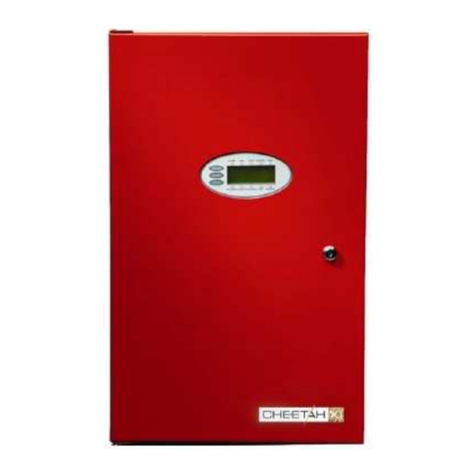
Fike
Fike Cheetah Xi User manual
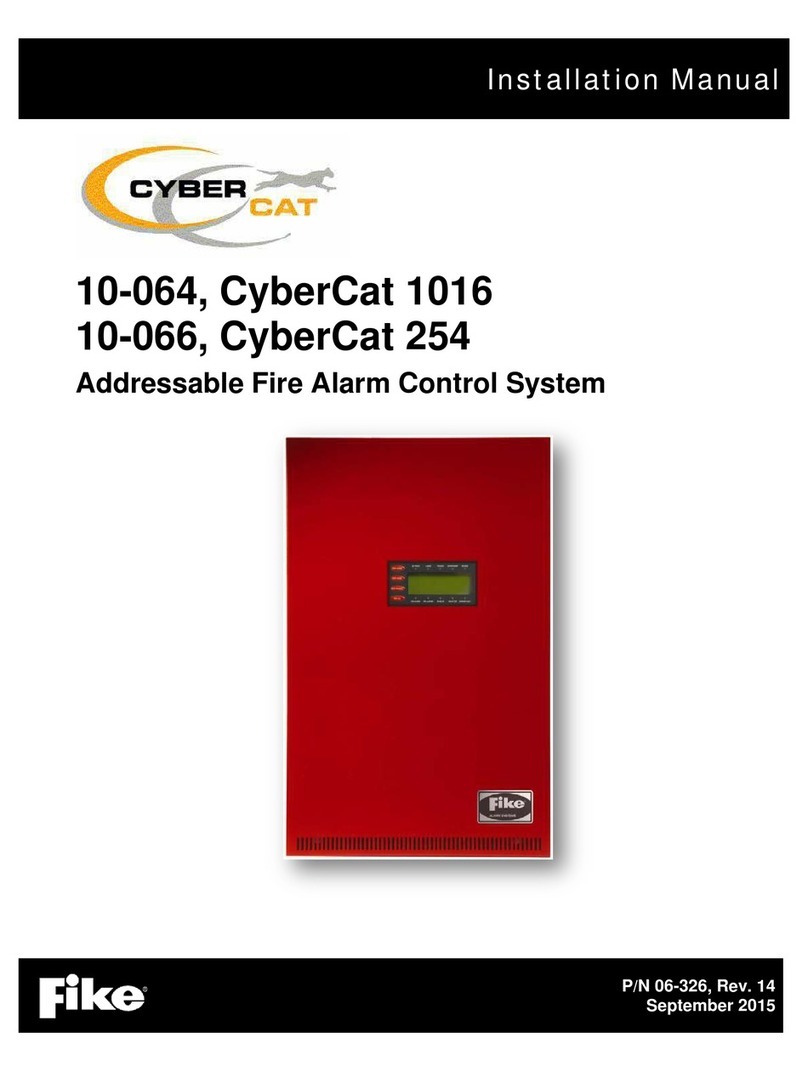
Fike
Fike CyberCat 1016 User manual
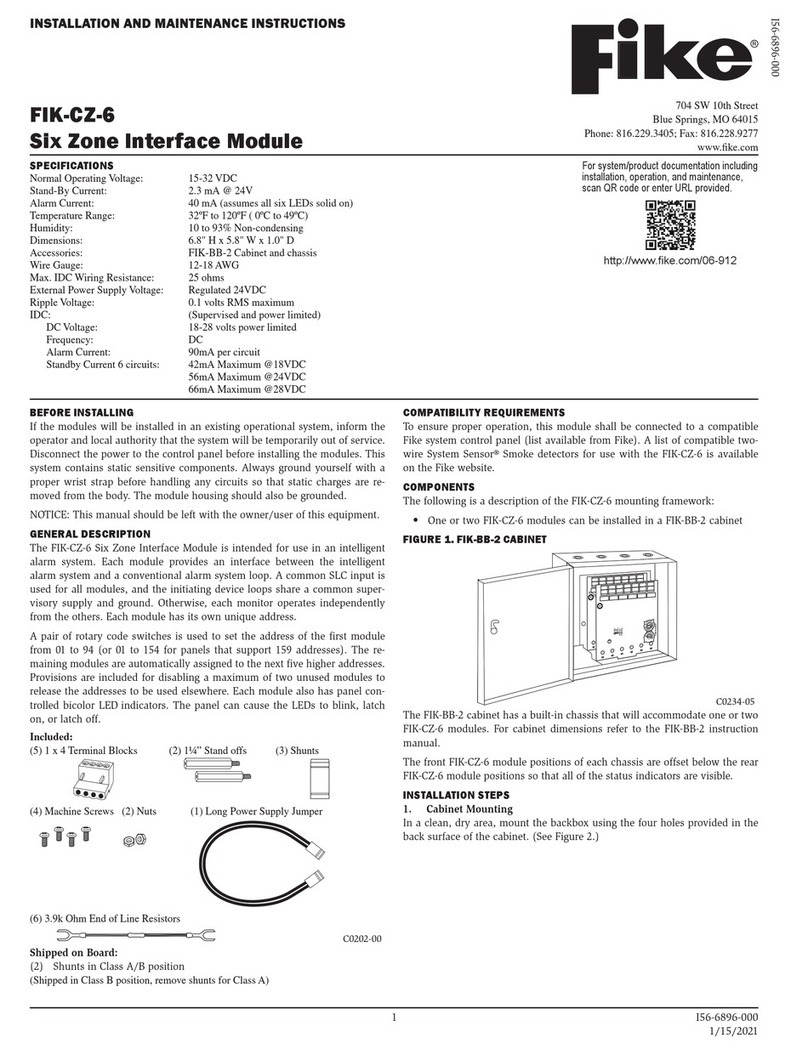
Fike
Fike FIK-CZ-6 User manual
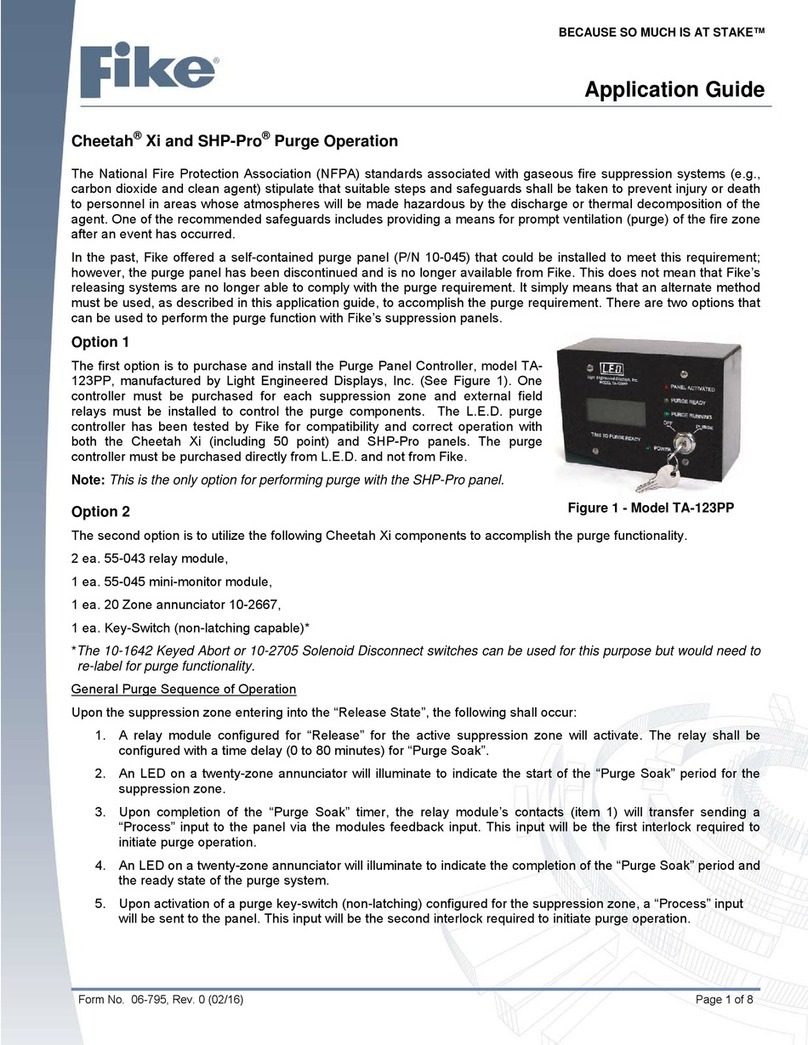
Fike
Fike Cheetah Xi User guide
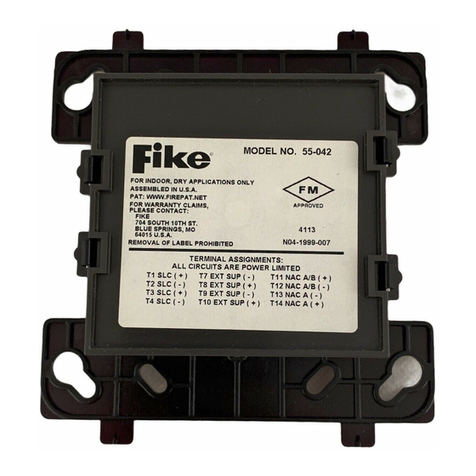
Fike
Fike 55-042 User manual
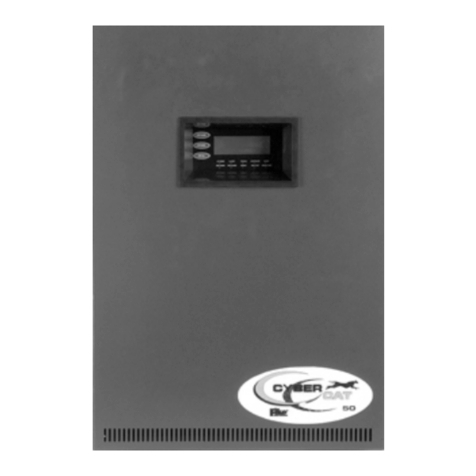
Fike
Fike CyberCat 50 10-070 Manual

Fike
Fike CyberCat 1016 Owner's manual

Fike
Fike 10-071 User manual

Fike
Fike CyberCat 1016 Manual

Fike
Fike 10-2539 Owner's manual




